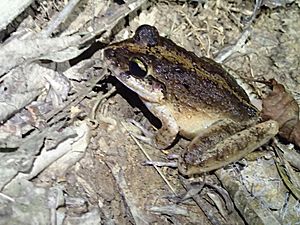Long-legged streamfrog facts for kids
Quick facts for kids Long-legged streamfrog |
|
|---|---|
 |
|
| In Stann Creek, Belize | |
| Conservation status | |
| Scientific classification | |
| Synonyms | |
|
The long-legged streamfrog (Craugastor sabrinus) is a type of frog that belongs to the Craugastoridae family. You can find this frog in Belize and the eastern parts of Guatemala. Its scientific name, sabrinus, comes from a Latin word meaning "river nymph." This name hints at where these frogs like to live: near streams.
Contents
What the Long-Legged Streamfrog Looks Like
Adult male long-legged streamfrogs are about 38 to 44 millimeters (1.5 to 1.7 inches) long. Female frogs are larger, measuring about 69 to 83 millimeters (2.7 to 3.3 inches) from snout to vent.
Their skin on the back can be smooth or slightly bumpy. They might have a few small bumps and faint ridges on their shoulders. The frog's eardrum, called the tympanum, is easy to see.
The tips of their fingers and toes are a bit wide, like small discs. Their fingers and toes also have thin edges or flaps along the sides. The toes are partly webbed, which helps them in water.
The frog's back can be dark olive-brown, reddish brown, or tan. Sometimes, a yellow, orange, or tan line runs down its spine. They often have a dark brown mark between their eyes, but it might be hard to see. Any larger bumps or folds on their skin are often tan or pale brown with black edges. Their legs have dark brown bars, but these are not very noticeable. The sides of their body are usually lighter in color.
Male frogs have a whitish throat with dark spots. Their chest is whitish, turning yellow on their belly. Female frogs have less yellow on their belly.
Where Long-Legged Streamfrogs Live and How They Grow
The long-legged streamfrog lives in wet and moist forests. These forests can be found in lowlands and on the lower parts of mountains, up to 900 meters (about 2,950 feet) above sea level. These frogs prefer to live in and next to clean, untouched streams. They do not usually live in forests that have been badly damaged. However, they can sometimes be found in areas that were once used for farming.
These frogs lay their eggs on land. Their development is "direct," which means the eggs hatch directly into small frogs. There is no tadpole stage that lives freely in the water.
Protecting the Long-Legged Streamfrog
The number of long-legged streamfrogs has gone down in Guatemala. However, they are still common in Belize. Their biggest threat is habitat loss, which means their natural homes are disappearing. This loss is mainly due to farms expanding. Other reasons include logging (cutting down trees), building dams for electricity, and mining for oil and minerals. The growing number of people also affects their habitat.
Luckily, these frogs live in several protected areas. These areas help keep their homes safe.
See also
 In Spanish: Craugastor sabrinus para niños
In Spanish: Craugastor sabrinus para niños


